Electrical Outlet Types
Types of Electrical Outlets In the Home
The average North American home has over 75 electrical outlets and various types of outlets in use.
A myriad of different types of electrical outlets are available, including 2-prong, 3-prong, GFCI, USB, AFCI, FBI, and CIA. (Okay, okay. We definitely made those last two up. Big Brother is not watching you through your electrical outlets, we promise.)
But our point is this: when it comes to delivering electricity, there are many types of outlets to choose from. What’s more, they come in quite a variety of types, sizes, shapes, and functionalities.
Do you know all the electrical outlet types in your home?
Are you using all your electrical outlets the right way and for the right job? Are all your electrical outlets up to code and safe? Should you be thinking about getting someone in to check, and upgrade your electrical outlets?
Although you probably think it’s not that important, knowing (and upgrading where necessary) the types of outlets in your home can make a big difference – to your safety, energy consumption, and daily living convenience.
Read on for a quick crash course on the most common electrical outlet types, and what you should be using each one for.
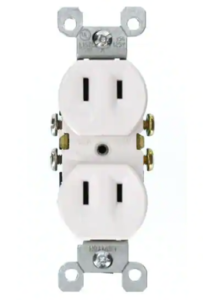 2-Prong Electrical Outlets
2-Prong Electrical Outlets
Although technically still allowed in Canada, 2-prong outlets are old and outdated and you may want to look into replacing 2-prong outlets if you have them (by a professional, might we add).
The 2-prong types of outlets are 15-amp, 125-volt, two-wired outlets commonly found in homes 50 years or older. Used for ungrounded circuits only, 2-prong outlets are being phased out due to safety issues and up-to-date electrical code requirements.
With zero grounding in the circuit, this is the least safe of all the electrical outlet types.
Looks Like: The 2-prong outlet features two long connection slots only, with no grounding wire.
Best Used For: 2-prong outlets are mostly still utilized for light home usage with appliances requiring minimum voltage or amperage. Think smaller appliances like kettles, handheld electric beaters, toasters, etc. For anything bigger requiring more power – think most heavy-duty appliances like smart TVs, vacuum cleaners, fans for example – 3-prong electrical outlets are essential.
 3-Prong Electrical Outlets
3-Prong Electrical Outlets
3-prong types of outlets, which are also 15-amp and 125-volts, have now become the standard outlet for homes and businesses.
It has all but replaced the 2-prong outlet as the standard for general light electrical usage in the home. These electrical outlet types are grounded with a third prong and are a lot safer than 2-prong outlets. 3-prong outlets also comply with our most up-to-date building codes.
Looks Like: The 3-prong outlet features two vertical slots similar to the 2-prong outlet, but with the addition of an upside-down U-shaped grounding hole below those slots. This grounding wire helps prevent electrical shock should any wiring come loose in any appliance plugged into these types of outlets.
Best Used For: Ideally, you should replace all 2-prong outlets with 3-prong outlets for light electrical usage in the home or at the office. In other words, all appliances are best plugged into a 3-prong outlet. 3-prongs outlets are crucial for safe usage of bigger appliances requiring more voltage and amperage, such as TVs, heaters, fans, vacuum cleaners etc.
 20-Amp Electrical Outlets – 125-Volt
20-Amp Electrical Outlets – 125-Volt
Large home appliances, especially those found in your kitchen and laundry room, require 20-amp electrical outlet types. This is where 20-amp, 125-volt outlets make their appearance.
Looks Like: These look similar to the 3-prong, 15-amp types of outlets, but with the addition of a T-shaped horizontal pin on the left vertical slot.
Best Used For: Refrigerators and laundry machines are two prime examples of appliances which need to be plugged into a 20-amp, 125-volt outlet. It is also highly recommended, however, that you use such outlets for things like mixers, blenders, and microwaves for example.
 20-Amp Electrical Outlets – 250-Volt
20-Amp Electrical Outlets – 250-Volt
Like the 125-volt outlet, the 20-amp, 250-volt outlet is used for appliances that are much larger and require a much higher voltage output.
Looks Like: These types of outlets look very similar to the 125-volt version.
Best Used For: These outlets are sometimes used for air compressors and other larger tools. In your home, for example, you might need one in your shop if you’re a keen home DIYer of any sort, or for some other hobby. More specifically, you’d use these outlets for things like window and portable AC units, water heaters, stoves, power tools, etc.
 GFCI Outlets
GFCI Outlets
GFCI outlets (Ground Fault Circuit Interrupters) are the outlets used in the areas in your home where water is in close proximity at all times: bathrooms, laundry rooms, kitchens, basements, outdoor areas, and so on.
GFCI electrical outlets work by using an internal breaker to trip if the circuit is shorted or overloaded, immediately stopping the power supply to the outlet in question.
This happens very quickly, in as little as 1/40 of a second. In doing this, it works to protect the house from electrical hazards, and protect you from electrical shocks. Once the outlet’s breaker trips, it then needs to be reset in order to restore the power supply to that outlet.
Looks Like: These types of outlets are easily identified by the two small, different coloured buttons in the centre of the outlet – a “TEST” button, and a “RESET” button.
Best Used For: GFCI outlets are best suited for places close to water: in your bathroom for your electric toothbrush; outdoors for your lawnmower; in your crawl space for lighting; in your laundry room for appliances other than your washer/dryer, etc.
AFCI Outlets
As you no doubt already know, some electrical faults will create heat and a potential fire hazard. This happens by a process known as arcing: where the electricity jumps between loose connections or contact points in your electrical system or wiring. (Telltale signs of this happening in your home are usually sparks or a buzzing sound.)
AFCI outlets (Arc Fault Circuit Interrupters) work to protect against arcing – and the potentially hazardous consequences of the extreme heat created from the arc. When arcing occurs, the AFCI outlet detects it and an integrated breaker immediately deactivates the outlet.
Looks Like: These types of outlets look very similar to a GFCI outlet.
Best Used For: AFCI outlets are an excellent, even crucial, choice for areas in your home where you might not always be awake and fully alert – like the bedroom, lounge, playroom, or TV room.
Tamper-Resistant Outlets
Tamper-resistant outlets, also known as childproof outlets, have a built-in physical barrier – think of them as internal shutters – which prevents the entry of foreign objects into the outlet slots.
For this barrier to disappear and these types of outlets to work, the internal shutters will only allow a recognized two-pronged or grounded plug to be inserted. Tamper-resistant outlets also work to remove any shock hazard at even an attempt to insert a foreign object.
Looks Like: These electrical outlet types look like your regular 2-prong or 3-prong outlet, but the packaging will be clearly marked as “tamper-resistant.”
Best Used For: Tamper-resistant outlets are great for homes with small children! Little ones are curious… which means they are prone to sticking all kinds of things into outlets when given half the chance! This is a fantastic option for your electrical outlets if you have, or are planning to have, small children in and around your home.
Other Modern Electrical Outlet Types
Like all things in life, advances and progress in electricity, safety, and building codes mean that new and improved, convenience-focused types of outlets continue to make their appearance.
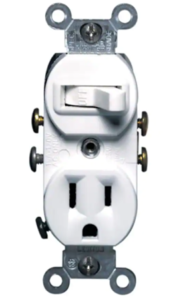
Switched Outlets
A switched outlet allows you to keep appliances or lights plugged in all the time even when they aren’t running or technically ‘on’. Think about your bedside lamp, for example, which you can control using the light switch at the entrance to your bedroom.
Switched outlets work by integrating a socket and a connected switch so that you can use the switch to control the power to the connected appliance without removing the plug from the outlet.
 USB Outlets
USB Outlets
Lost your iPad charger again? Your smartphone is dead at bedtime, yet again, and you can’t go to sleep unless it is both charging and within arm’s reach? Far from being a judgment on your phone usage, for most of us, this is actually a safety issue.
Enter USB types of outlets.
Technology-friendly and convenience-orientated, USB electrical outlets are a modern home improvement designed to match your mobile-friendly lifestyle. They are also popular for leasehold improvements.
USB outlets are strategically placed wall outlets (like next to your bed, ready to grab at a moment’s notice) which feature one or more USB ports.
Just plug your charger cables directly into the wall to recharge your smartphone, tablet, or another USB device.
Bonus: never fight with your spouse again over who’s turn it is to use the one and only compatible charger brick again!
Smart Outlets
Smart outlets are increasingly popular in new home construction and the homes of those who seek to increase both lifestyle and energy efficiency. Smart outlets feature built-in mechanisms for monitoring power usage.
As part of this monitoring process, they also give users the ability to switch outlets on and off by following a program or schedule. This works well for things like lawn sprinklers and coffee makers.
But all convenience aside, smart outlets are also a smart choice to help monitor energy usage, and thus help make your home more energy efficient.
Summary
The right types of outlets, expertly installed in all the right places for all the right jobs, can dramatically improve both the electrical safety and energy efficiency of your home.
Our team of Premium Electric electricians can give you expert advice on all the electrical outlets in your home, and improve or upgrade your electrical systems where necessary, with minimum fuss and effort.
We only employ fully bonded, certified electricians who are ready to help light up your life by making it safer, more convenient, and more energy efficient. If you need an electrician in Langley, Abbotsford, Chilliwack, or Mission, we are available 24/7.
Give us a call at 604-308-6195 or contact us online at any time if you still have questions about electrical outlets or if you need an electrician for an electrical outlet that is not working.
We can also be reached by email.

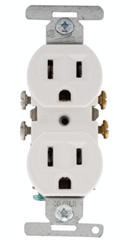 3-Prong Electrical Outlets
3-Prong Electrical Outlets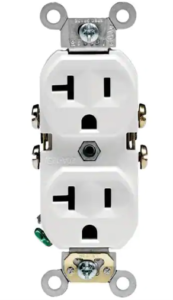 20-Amp Electrical Outlets – 125-Volt
20-Amp Electrical Outlets – 125-Volt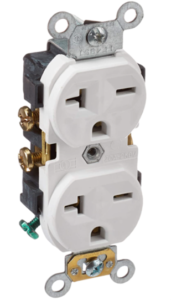 20-Amp Electrical Outlets – 250-Volt
20-Amp Electrical Outlets – 250-Volt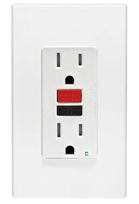 GFCI Outlets
GFCI Outlets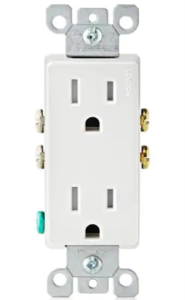
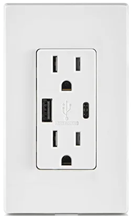 USB Outlets
USB Outlets